Numbers in Spanish 💯 How to Count from 0-900
Learn to Count in Spanish PLUS Take Our Spanish Numbers Quiz 🔢
There are two main systems in Spanish used to express numbers as graphic symbols. The first is the Arabic system (0, 1, 2, 3…) and the second is the Roman system, (I, II, III…).

Although the two co-exist today, around about the Middle Ages, the Arabic system practically ended up substituting the Roman system, the latter now only being used residually.
The Arabic system combines any of the 10 digits: 0, 1, 2, 3, 4, 5, 6, 7, 8, 9, while the Roman system uses seven letters from the Latin alphabet (I, V, X, L, C, D, M) each letter having a specific assigned value.
👉 So in this blog, we’re going to teach you about numbers, all the relevant words, phrases and cultural insights you need to navigate all about numbers in Spain!
Let’s break down the numbers in Spanish, or números
Numbers in Spanish || Let’s Count in Spanish
Numbers in Spanish || Good Grammar Applies to Numbers Too
Numbers in Spanish || Numbers in Words or Digits?
Numbers in Spanish || Quiz
Numbers in Spanish || FAQs
Numbers in Spanish || Let’s Count in Spanish
🔏 The secret to learning to count in Spanish is… well, learning the basic numbers in Spanish and some memory work.
👉 Let’s start with the basics, 0-10. These units form the basis of counting and will normally be used in an additive format when constructing the bigger digits.
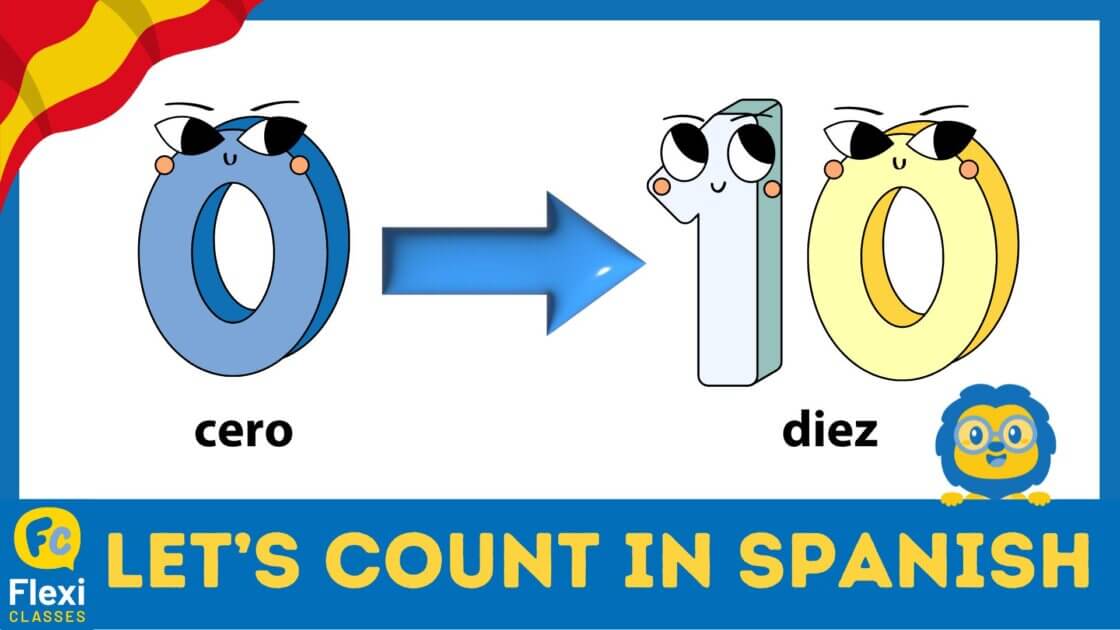
| spanish | number |
|---|---|
| cero | 0 |
| uno | 1 |
| dos | 2 |
| tres | 3 |
| cuatro | 4 |
| cinco | 5 |
| seis | 6 |
| siete | 7 |
| ocho | 8 |
| nueve | 9 |
| diez | 10 |
Numbers 11-20
The following numbers still do not follow a regular additive pattern, so memory work is still a must.
| Spanish | english |
|---|---|
| once | 11 |
| doce | 12 |
| trece | 13 |
| catorce | 14 |
| quince | 15 |
| dieciséis | 16 |
| diecisiete | 17 |
| dieciocho | 18 |
| diecinueve | 19 |
| veinte | 20 |
Numbers 21-29
For these numbers in Spanish, we follow a particular pattern by using the prefix “veinti”, followed by the specific unit, like so:
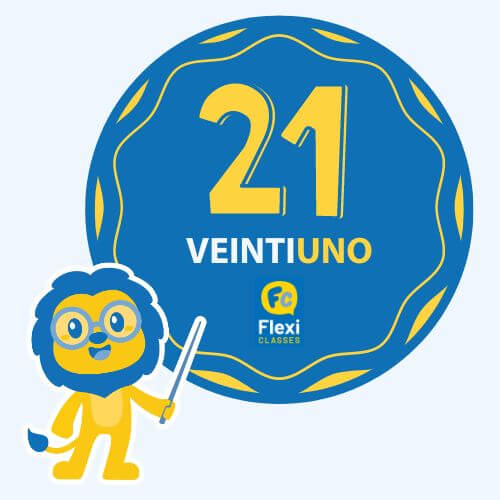
| spanish | number |
|---|---|
| veintiuno | 21 |
| veintidós | 22 |
| veintirés | 23 |
| veinticuatro | 24 |
| veinticinco | 25 |
| veintiséis | 26 |
| veintisiete | 27 |
| veintiocho | 28 |
| veintinueve | 29 |
Numbers 30-99
For numbers 30-99, we use a regular additive pattern that consists of combining the tens and the units with a “y” (and), like so:
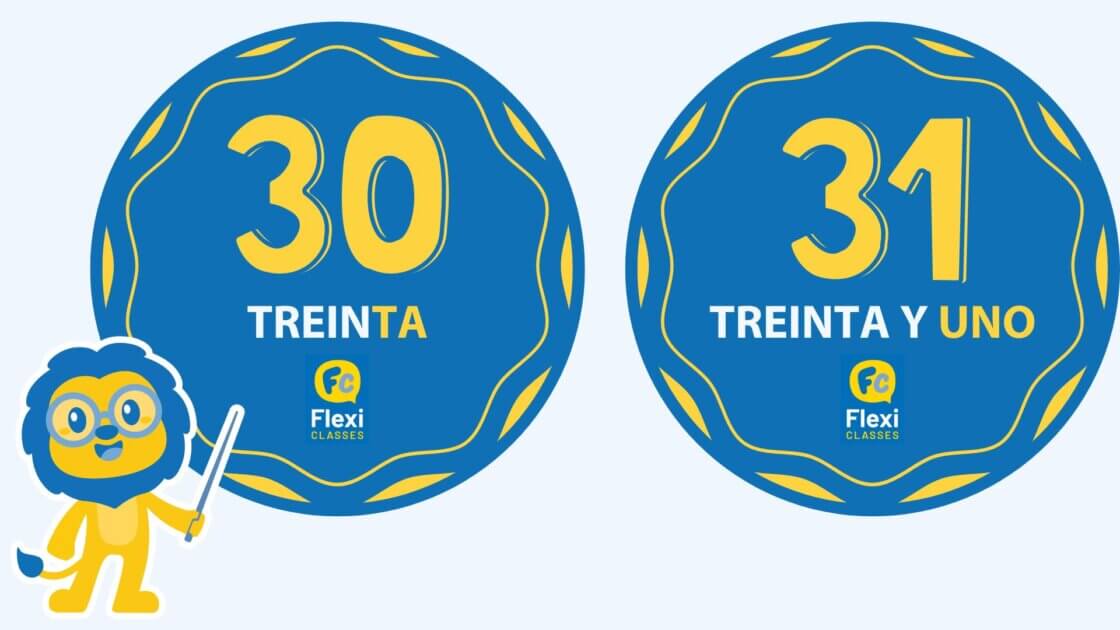
| Spanish | number |
|---|---|
| treinta | 30 |
| treinta y uno | 31 |
| treinta y dos | 32 |
| treinta y tres | 33 |
| treinta y cuatro | 34 |
| treinta y cinco | 35 |
| treinta y seis | 36 |
| treinta y siete | 37 |
| treinta y ocho | 38 |
| treinta y nueve | 39 |
The construction of the tens and units below just follows the same additive format as shown prior.
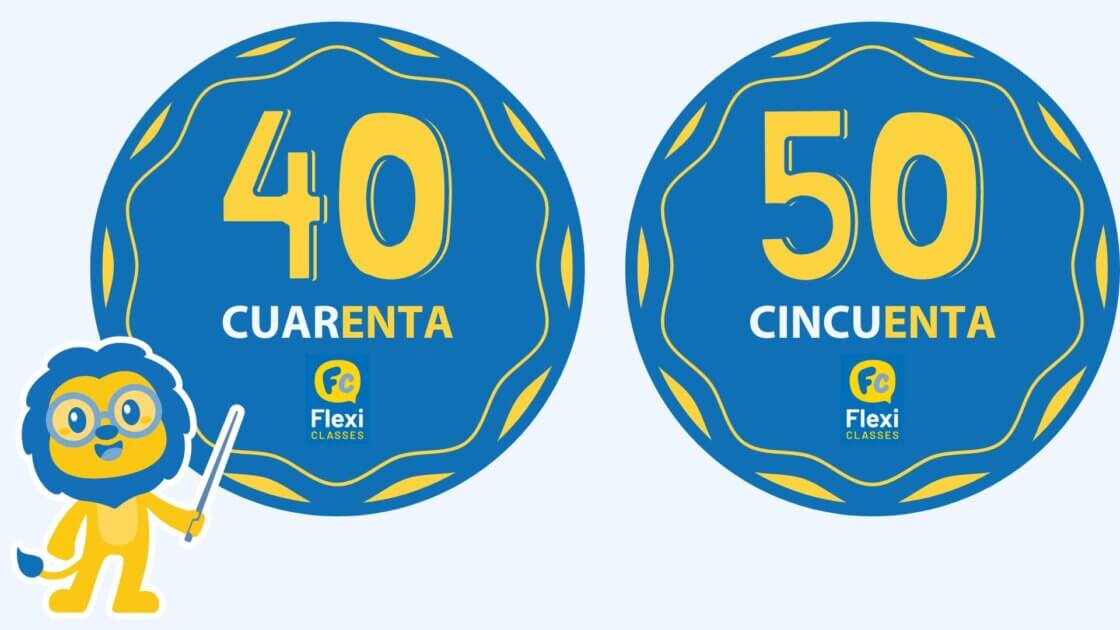
| spanish | number |
|---|---|
| cuarenta | 40 |
| cincuenta | 50 |
| sesenta | 60 |
| setenta | 70 |
| ochenta | 80 |
| noventa | 90 |
Numbers 100-999
Each hundred has its particular denomination, as shown below. One hundred is referred to as cien. However, the digits following 100 are referred to as ciento and from 200 onwards as cientos, like so:
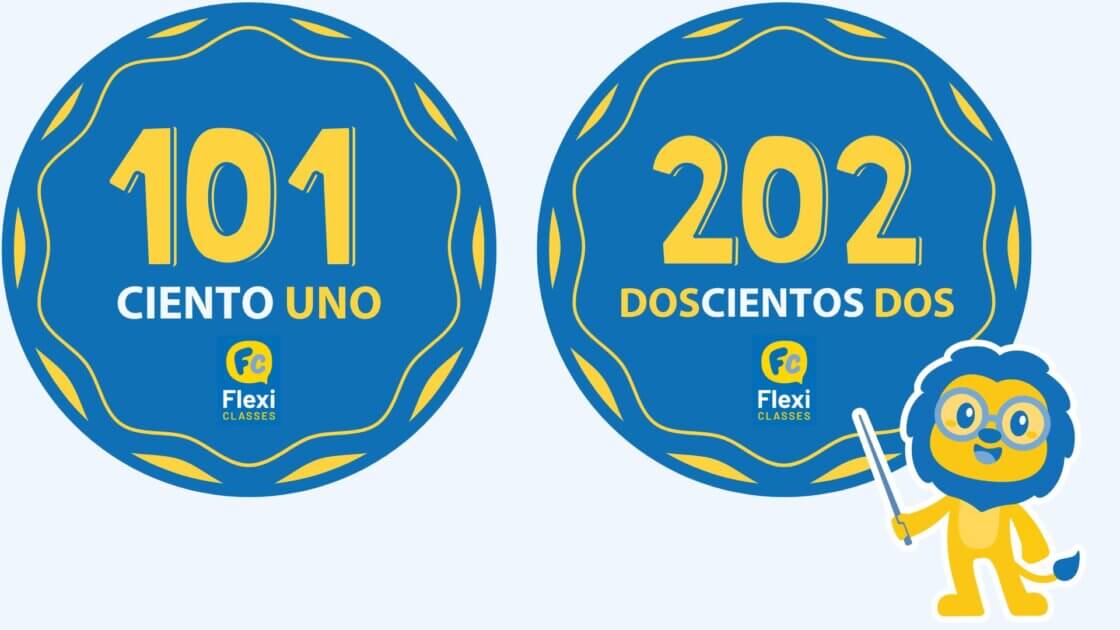
| spanish | number |
|---|---|
| cien | 100 |
| ciento uno | 101 |
| ciento dos | 102 |
| doscientos | 200 |
| doscientos uno | 201 |
| doscientos dos | 202 |
| trescientos | 300 |
| cuatrocientos | 400 |
| quinientos | 500 |
| seiscientos | 600 |
| setecientos | 700 |
| ochocientos | 800 |
| novecientos | 900 |
Numbers in Spanish ||
Good Grammar Applies to Numbers Too
There’s no getting away from good grammar, as it applies to numbers as well. Let’s go through the basics of good grammar for numbers in Spanish.
Separation of digits
🔏 This one might come as a shocker but it’s true, contrary even to what one might have been taught in school!
According to the Real Academia Española (the foremost authority in the Spanish language), to facilitate reading numbers, they can be separated by blocks of three or four digits by a narrow blank space (a blank space narrower than the usual), like so:
263 755
1 200 991
1 345 or 1345
👉 Contrary to what is commonly used, correct Spanish grammar does not allow using a period (.) or a comma (,) when separating digits by blocks of three. The following examples would be considered incorrect (yes, you read that right, incorrect):
263,755 or 263.755
1,200,991 or 1.200.991
1,345 or 1.345
Representing decimals
👉 The use of a comma (,) or a period (.) is only admitted when used to separate the integers from the decimals. Both the comma and the period are accepted, it just boils down to the preference of use by each country.
These would be the correct examples of use for the (,) and the (.)
1.25 or 1,25
π = 3.1416 or π = 3,1416
The criterion above for separating numbers is based on the international norms established by the BIPM (Bureau International des Poids et Mesures) which is the global coordinator for measurements.
Numbers in a series
👉 A number that does not express a quantity but rather identifies an element within a series (like a year, pages, verses, postal codes, street numbers, legal article numbers, registration numbers, etc.) should not be separated by a period (.), a comma (,) or a space.
Some examples of the correct way to enumerate numbers within a series would be:
año 2024 (if referring to a year)
página 1124 (if referring to a page)
1676 (if referring to an article within a legal text/law)
C.P. 08021 (if referring to a postal code)
Reg. 101389 (if referring to a registration number)
DNI: 45231289 (if referring to the Spanish I.D. number)
Numbers in Spanish ||
Numbers in Words or Digits?
How to know when it is grammatically correct to use words or digits to express a number in Spanish?
Well, although this will depend on a series of factors (such as the context of use, the complexity of the number and the type of text that the number is used in), there are some general guidelines of use to help determine which format to use:
Uses wherein numbers are expressed in digits, as the digits are more concise and facilitate clarity:
– 📑 in scientific or technical texts/papers;
– 📐 in formulas and mathematical equations;
– 📊 in computations, statistics, inventories, charts, etc. or any type of document/context where the use of numbers is constant;
– 💬 in signages, labels, marketing slogans/texts, etc.
Uses wherein numbers are expressed in words: literary works and non-technical documents, as it is considered more elegant to phrase a number using words within these types of documents.
However, there are several contexts of use wherein numbers expressed in digits are still recommended even in non-technical or literary works, mostly for the sake of clarity and concision.
👉 So when the number is complex, pertains to an equation or to a series of numbers, refers to a year, a street number, measurements, etc., numbers expressed in digits are still your go-to.
To learn more about Nice to meet you, check out this!

Nice to Meet You in Spanish – Essential After an Introduction Vocabulary 🇪🇸👋
Nice to Meet You in Spanish Is Much More Than Just a Courtesy Reply – Tips for When Being Introduced 👫 First impressions are what count, or so the adage goes. So if we want to make a good and…
Numbers in Spanish || Quiz
If you want an extra challenge, why learn to count in our other languages:
Numbers in Spanish || FAQs
Do Spanish use commas in numbers?
Yes, commas are used when separating a decimal number from the integer, like so:
π = 3,1416
That said, although it is more customary in Spain to use the comma when expressing a decimal number in digits, it is also grammatically correct to use a period as well, like so:
π = 3.1416
What is 1 billion in Spanish?
While one million in English and in Spanish both equate to the same number and are expressed the same way (see below):
In English: 1 000 000 (one million)
In Spanish: 1 000 000 (un millón)
when we hit the billion, in English that same number is expressed differently than in Spanish, like so:
In English: 1 000 000 000 (one billion)
In Spanish: 1 000 000 000 (mil millones)
If we refer to a billion in Spanish (un billón), these are the equivalents:
In English: 1 000 000 000 000 (one trillion)
In Spanish: 1 000 000 000 000 (un billón)
How to write ordinal numbers in Spanish?
Ordinal numbers express the position or order of an element in a sequence. Cardinal numbers mostly refer to quantity (1, 2, 3, etc.), while ordinal numbers refer to a rank or position (first, second, third, etc.).
These are the first ten ordinal numbers in Spanish:
primero / primera (first)
segundo / segunda (second)
tercero / tercera (third)
cuarto / cuarta (fourth)
quinto / quinta (fifth)
sexto / sexta (sixth)
séptimo / séptima (seventh)
octavo / octava (eigth)
noveno / novena (ninth)
décimo / décima (tenth)
Bear in mind that in Spanish, when using ordinal numbers, they must agree in gender and number with the nouns they modify.
Do Spanish use periods in numbers?
While in Spain you might commonly see numbers being separated by groups of three digits, with commas (,) in between, know that it is not grammatically correct to separate digits of numbers with a comma or a period (except when referring to decimals).
The correct way to separate digits is by batches of three or four and with a blank space narrower than the usual, like so:
Incorrect: Correct:
1.000.000 1 000 000
1,000,000 1 000 000
1.277 1 277 or 1277
This is in accordance with the international norms established by the BIPM (Bureau International des Poids et Mesures), the global coordinator for measurements, applied in turn by the Real Academia Española (the foremost authority in the Spanish language).
How do you say decimal numbers in Spanish?
To express decimal numbers, first express the integer and then the decimal, combined with the preposition “y” (and) or “con” (with). For example, the number 1,14 can be expressed in either way:
una unidad con catorce centésimas (one unit with fourteen hundredths) or
una unidad y catorce centésimas (one unit and fourteen hundredths)
Another accepted form that is frequently used for verbally expressing decimals is by reading the sequence of numbers together with the symbol (.) or (,) used to separate the integer from the decimals, like so:
Using the same digits as an example: 1,14 would be read as uno coma catorce (one comma fourteen) and 1.14 would be read as uno punto catorce (one point fourteen).
The above format is not acceptable though in the written form when used in technical, official and accounting documents.
When expressing decimals in digits, both the use of a comma (,) or a period (.) to separate the integer and the decimal are grammatically correct in Spanish, it just is a matter of preference or general usage of each country.
So, for example, either 1,14 or 1.14 can be used and are acceptable.
Want More From LTL?
FANCY LEARNING SPANISH? Check out our online Spanish courses here.
We offer a 7-day free trial to all online students where you can study Spanish 24/7. It doesn’t end there either.
We teach over 10 of the world’s most popular languages 😎
Come and be a part of our amazing community.











